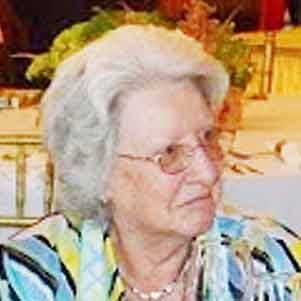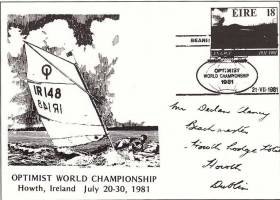Displaying items by tag: Helen Mary Wilkes
World Sailing’s Gold Medal for Ireland’s Helen Mary Wilkes
A lifetime of enthusiastic and effective dedication to voluntary work in international sailing administration has very deservedly resulted in the award of World Sailing’s Gold Medal to Ireland’s Helen Mary Wilkes writes W M Nixon.
She is originally from Scotland while her husband Robert is from England. But when they settled in Ireland in 1969, Howth became their home, sailing became their family sport, and both their sons Tom and Rupert sailed – and still sail - for Ireland.
However, the fact that Helen Mary and Robert together provided a brilliant administrative and creative team was quickly recognized locally and nationally, and it was recognition which became international when Howth Yacht Club took on the staging of the Optimist Worlds in 1981.
 Wall-to-wall Optimist dinghies from dozens of countries at the Worlds in Howth in 1981 – this is how it looks in a double-page spread in the HYC Centenary History, published 1995
Wall-to-wall Optimist dinghies from dozens of countries at the Worlds in Howth in 1981 – this is how it looks in a double-page spread in the HYC Centenary History, published 1995
That would be a relatively straightforward business with today’s modernized facilities. But Howth in 1981 was in the throes of harbour re-development, yet bits of it still functioned as both a sailing and fishing port.
Thus the staging of the worlds was based on the beachside Claremont Hotel immediately west of the Harbour (it has long since disappeared into a large complex of up-market apartments), and much of the running of this huge event had to be developed from scratch.
But with Helen Mary Wilkes in the key position as Secretary to the Organising Committee and Robert in several other roles, the racing for hundreds of Optimists - in what was then the most international sailing event ever seen in Ireland - was successfully completed. The overall winner was Guido Tavelli of Argentina, while the top girl (and best Irish at 17th overall) was 13-year-old Denise Lyttle of the National YC.
 Helen Mary Wilkes (centre) with Viggo and Edith Jacobsen, the founders in 1962 of the International Optimist Dinghy Association, at a major regatta in 1990
Helen Mary Wilkes (centre) with Viggo and Edith Jacobsen, the founders in 1962 of the International Optimist Dinghy Association, at a major regatta in 1990
For most folk in Howth, that was enough involvement in international sailing administration until the new HYC marina and clubhouse were fully functional by 1987. But Helen Mary and Robert Wilkes had been spotted by the powers-that-be as talents that could usefully be deployed on the world stage, and Helen Mary’s subsequent rise through the global and national ranks of sailing administration has been so all-encompassing that it’s best summarized in a basic list:
International Sailing Federation (now World Sailing)
1982 - 1998 International Classes Committee
1990 - 1994 CPOC
1994 - 1998 Events Committee
1994 - 1998 Vice-chair, International Classes Committee (elected)
1998 - 2000 Match Racing Committee
2006 & 2008 Nominated for IOC Women & Sport Award
2008 ISAF President’s Development Award (jointly)
2008-2016 Vice-chair, ISAF Classes Committee
International Optimist Class
1978 - 1982 Secretary, IODA of Ireland
1982 - 1987 President, IODA of Ireland
1982 - 1985 Regatta Committee, IODA
1985- 1989 Vice-President
1989 - 1998 President
During that presidency the Class became the largest in the world:
- national membership rose by 78% to 87 countries
- participation at international events rose by 50% to 57 countries
1998 - 2005 Member of Honour
2005 - President of Honour
Match Racing
In 1996 Helen Mary was asked by Paul Henderson (ISAF President) to promote women’s match-racing towards Olympic status and became the first president of the Women’s International Match-Racing Association. The number of active teams and countries increased by nearly 50%.
Irish Sailing Association
1990 - 1998 Council
1992 - 2000 Olympic Committee/Group
World Sailing
March 2017 Gold Medal awarded to Helen Mary Wilkes by newly-elected World Sailing President Kim Andersen
While Helen Mary Wilkes’ many significant roles have made her the more prominent of this remarkable couple, Robert has been busy behind the scenes, and among other things - in addition to being Secretary for 35 years to the International Optimist Class Association - in 2007 he produced a profusely-illustrated history of the first sixty years of this incredibly successful little boat, with additional input from Clifford McKay Jr, who was the first Opty sailor in Florida way back in 1947.
 Helen Mary and Robert Wilkes on being inducted into the Irish Sailing Association’s Hall of fame in 2009
Helen Mary and Robert Wilkes on being inducted into the Irish Sailing Association’s Hall of fame in 2009
Being the sons of such busy and interesting parents made for a special up-bringing for Tom and Rupert. It’s all of a piece that Tom should be involved on the technical side of sailing – he runs a carbon spar-making business in the Netherlands which, in honour of home, he calls Ceilidh Composites. As a result he is a veteran of several Fastnets and Sydney-Hobarts. Rupert has elected to work ashore, but it’s something equally interesting – he restores classic and antique buildings.
However, this week it’s their parents and their enormous contribution to national and international sailing which is deservedly top of the agenda. Our heartiest congratulations to Helen Mary Wilkes on her newly-awarded World Sailing Gold Medal.
 Gold Medallist. Helen Mary Wilkes today
Gold Medallist. Helen Mary Wilkes today






























































